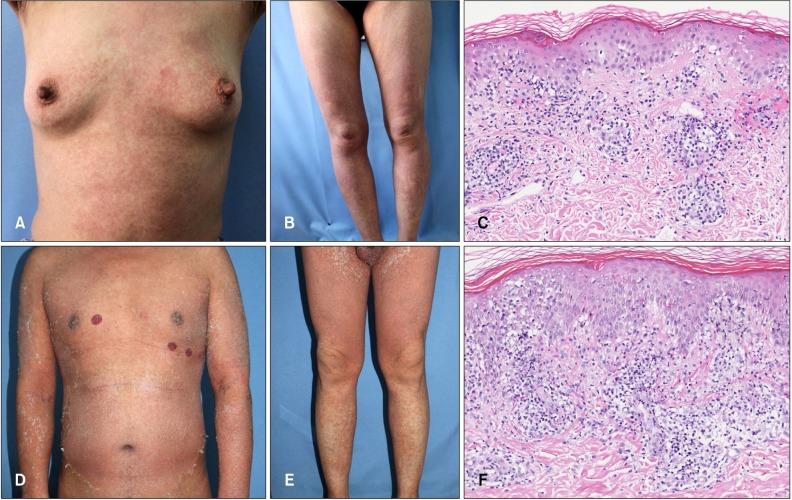Ann Dermatol.
2018 Feb;30(1):71-74. 10.5021/ad.2018.30.1.71.
Drug Reaction with Eosinophilia and Systemic Symptoms Associated with Reactivation of Epstein-Barr Virus and/or Cytomegalovirus Leading to Hemophagocytic Syndrome in One of Two Patients
- Affiliations
-
- 1Department of Dermatology, Peking University First Hospital, Beijing, China. wangmy@pku.edu.cn
- 2Department of Dermatology, Liaocheng People's Hospital, Shandong, China.
- 3Beijing Key Laboratory of Molecular Diagnosis of Dermatoses, Beijing, China.
- KMID: 2399757
- DOI: http://doi.org/10.5021/ad.2018.30.1.71
Abstract
- Drug reaction with eosinophilia and systemic symptoms (DRESS) is a hypersensitivity reaction characterized by maculopapular rash, exfoliative dermatitis, lymphadenopathy, fever, eosinophilia, and involvement of internal organs. Evidence for reactivation of herpes family viruses has been observed in some DRESS patients, and activated CD8+ T lymphocytes are largely directed against Epstein-Barr virus. Here, we report two cases complicated with this infection. Both patients received antibiotics and non-steroidal anti-inflammatory drugs. These patients manifested clinically with high fever, facial edema, diffuse pruritic erythroderma and maculopapules over the entire body, purpuric rashes in both lower limbs and lymphadenopathy of cervical and inguinal nodes. Laboratory tests revealed abnormal liver function, blood eosinophils, and ferritin levels. The patients recovered completely; however, the female patient developed hemophagocytic syndrome on the 15th day of illness. She developed new itchy rash, and laboratory tests rapidly worsened with fibrinogen levels dramatically reduced to 0.61 g/L. Bone marrow aspiration revealed an increased number of macrophages with hemophagocytosis and a reversed CD4/CD8 ratio of 0.45. These cases suggest that human herpes virus and coagulation function evaluations are necessary in DRESS patients.
Keyword
MeSH Terms
-
Anti-Bacterial Agents
Bone Marrow
Cytomegalovirus*
Dermatitis, Exfoliative
Drug Hypersensitivity Syndrome*
Edema
Eosinophilia
Eosinophils
Epstein-Barr Virus Infections
Exanthema
Female
Ferritins
Fever
Fibrinogen
Herpesvirus 4, Human*
Humans
Hypersensitivity
Liver
Lower Extremity
Lymphatic Diseases
Lymphohistiocytosis, Hemophagocytic*
Macrophages
Sulfasalazine
T-Lymphocytes
Anti-Bacterial Agents
Ferritins
Fibrinogen
Sulfasalazine
Figure
Reference
-
1. Nanishi E, Hoshina T, Ohga S, Nishio H, Hara T. Drug reaction with eosinophilia and systemic symptoms during primary Epstein-Barr virus infection. J Microbiol Immunol Infect. 2015; 48:109–112. PMID: 25074626.
Article2. Kardaun SH, Sidoroff A, Valeyrie-Allanore L, Halevy S, Davidovici BB, Mockenhaupt M, et al. Variability in the clinical pattern of cutaneous side-effects of drugs with systemic symptoms: does a DRESS syndrome really exist? Br J Dermatol. 2007; 156:609–611. PMID: 17300272.
Article3. Girelli F, Bernardi S, Gardelli L, Bassi B, Parente G, Dubini A, et al. A new case of DRESS syndrome induced by sulfasalazine and triggered by amoxicillin. Case Rep Rheumatol. 2013; 2013:409152. PMID: 23936716.
Article4. Drago F, Cogorno L, Broccolo F, Ciccarese G, Parodi A. A fatal case of DRESS induced by strontium ranelate associated with HHV-7 reactivation. Osteoporos Int. 2016; 27:1261–1264. PMID: 26519419.
Article5. Picard D, Janela B, Descamps V, D'Incan M, Courville P, Jacquot S, et al. Drug reaction with eosinophilia and systemic symptoms (DRESS): a multiorgan antiviral T cell response. Sci Transl Med. 2010; 2:46ra62.
Article6. Ishida T, Kano Y, Mizukawa Y, Shiohara T. The dynamics of herpesvirus reactivations during and after severe drug eruptions: their relation to the clinical phenotype and therapeutic outcome. Allergy. 2014; 69:798–805. PMID: 24749495.
Article7. Nishio D, Izu K, Kabashima K, Tokura Y. T cell populations propagating in the peripheral blood of patients with drug eruptions. J Dermatol Sci. 2007; 48:25–33. PMID: 17601705.
Article8. Filipovich AH. The expanding spectrum of hemophagocytic lymphohistiocytosis. Curr Opin Allergy Clin Immunol. 2011; 11:512–516. PMID: 21971331.
Article
- Full Text Links
- Actions
-
Cited
- CITED
-
- Close
- Share
- Similar articles
-
- A Case of Epstein-Barr Virus-Associated Hemophagocytic Syndrome Demonstrated by In Situ Hybridization
- A Case of Epstein-Barr Virus-Associated Hemophagocytic Syndrome with Ascites
- A case of hemophagocytic lymphohistiocytosis caused by an Epstein-Barr virus infection, presenting with unremitting fever and rash
- A Case of Epstein Barr Virus-Associated Hemophagocytic Syndrome Confirmed by mRNA In Situ Hybridization and Polymerase Chain Reaction
- Anticonvulsant Hypersensitivity Syndrome Associated with Epstein-Barr Virus Reactivation


